YouTube Video: Swing Trading with Renko Charts
In this video, we explore the dynamic realm of Renko charts and unveil five potent strategies for successful swing trading. Join us on this journey as we break down each strategy with real-life examples to empower your trading decisions.
What You’ll Learn:
- How to effectively utilize Renko charts in swing trading.
- Insights into five powerful swing trading strategies using Renko charts.
- Real-life examples illustrating the implementation of each strategy.
- Tips and best practices for enhanced decision-making in swing trading.
Table of Contents
Introduction
Renko charts are a unique type of price chart used in technical analysis, focusing solely on price movements while disregarding time and volume. They offer distinct advantages for swing trading strategies, where positions are typically held for a few days to weeks. Let’s delve deeper into these strategies and explore additional points to consider.
Advantages of Renko Charts for Swing Trading
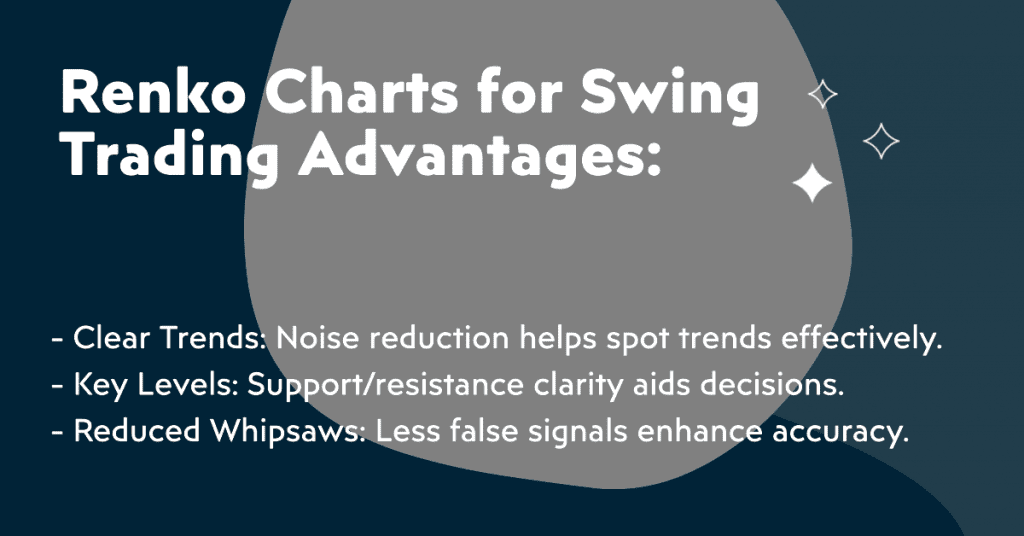
Clear Trends
Renko charts are exceptional at filtering out noise, facilitating the identification of trends. This is particularly beneficial for swing traders aiming to capture sustained price movements.
Example: Let’s say you’re swing trading a stock using both traditional candlestick charts and Renko charts. On the candlestick chart, you might notice frequent price fluctuations that make it challenging to discern the underlying trend. However, when you switch to a Renko chart, you observe a series of bricks moving consistently in one direction, indicating a clear uptrend. This clarity helps you make informed decisions about the trend’s strength and potential entry points.
Key Levels
Support and resistance levels become more evident on Renko charts due to the elimination of minor price fluctuations. These levels can serve as crucial decision points for entry, exit, and stop-loss orders.
Example: Consider you’re analyzing a stock’s Renko chart to identify key support and resistance levels. On a traditional chart, these levels might not be as clear due to minor price fluctuations. However, on the Renko chart, you notice that price consistently reverses at a specific level, forming a clear support area. This insight prompts you to set your entry just above this level, with a target at the next resistance area identified on the Renko chart.
Reduced Whipsaws
Renko charts aid in sidestepping false signals and whipsaw movements that can confound traders on traditional time-based charts.
Example: Imagine you’re using Renko charts to trade a currency pair. On a traditional time-based chart, you might have encountered multiple false signals caused by short-lived price spikes. However, when you switch to a Renko chart, these spikes are filtered out, revealing a smoother and more consistent price trend. This reduction in noise helps you avoid entering trades based on false signals and enhances the accuracy of your trading decisions.
Additional Points to Consider
Multiple Timeframes
Analyzing Renko charts on different timeframes can provide a comprehensive view of trends, helping traders spot both short-term and long-term patterns.
Volatility Adjustments
Tailoring Renko brick sizes to match asset volatility ensures that signals remain relevant. This adjustment can optimize trading decisions across various market conditions.
Patience and Discipline
Renko charts generate fewer signals, demanding patience and discipline. Waiting for confirmed signals helps traders make well-informed decisions.
False Signals
While Renko charts excel at noise reduction, false signals can still occur. Traders should validate signals using additional indicators or patterns.
Backtesting and Optimization
Thoroughly backtesting Renko-based strategies and optimizing parameters, such as brick size and exit strategies, contribute to more effective trading plans.
Psychological Aspects
Managing emotions is vital in swing trading. Despite the clarity Renko charts offer, traders must adhere to their strategies and avoid emotional decisions.
Renko Swing Trading Strategies
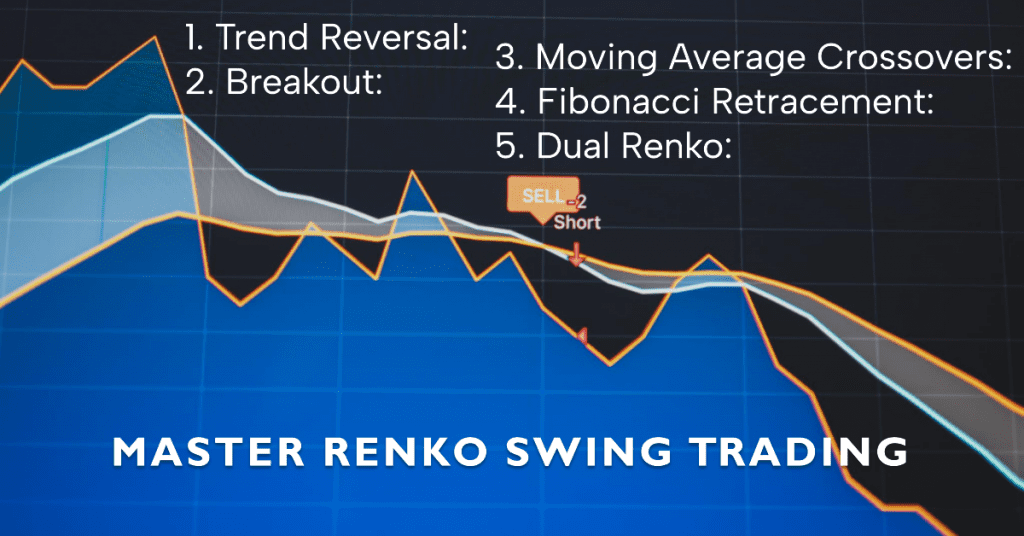
1. Trend Reversal Strategy
- Setup: Identify a strong uptrend on the Renko chart. Look for a series of bricks changing direction and slowing down.
- Entry: Once a series of reversal bricks forms, wait for a confirming brick to close in the new direction.
- Exit: Set an exit target at a key support level identified on the Renko chart. For a stronger reversal, use a trailing stop.
Example: Suppose you’re observing an uptrend in a stock’s Renko chart. As bricks start to change direction and slow down, you wait for a series of bricks forming in the opposite direction. Once this series is confirmed by a closing brick, you enter a short trade. For the exit, you identify a significant support level on the Renko chart, where you set your target. Alternatively, you can use a trailing stop to capture additional gains if the reversal gathers momentum.
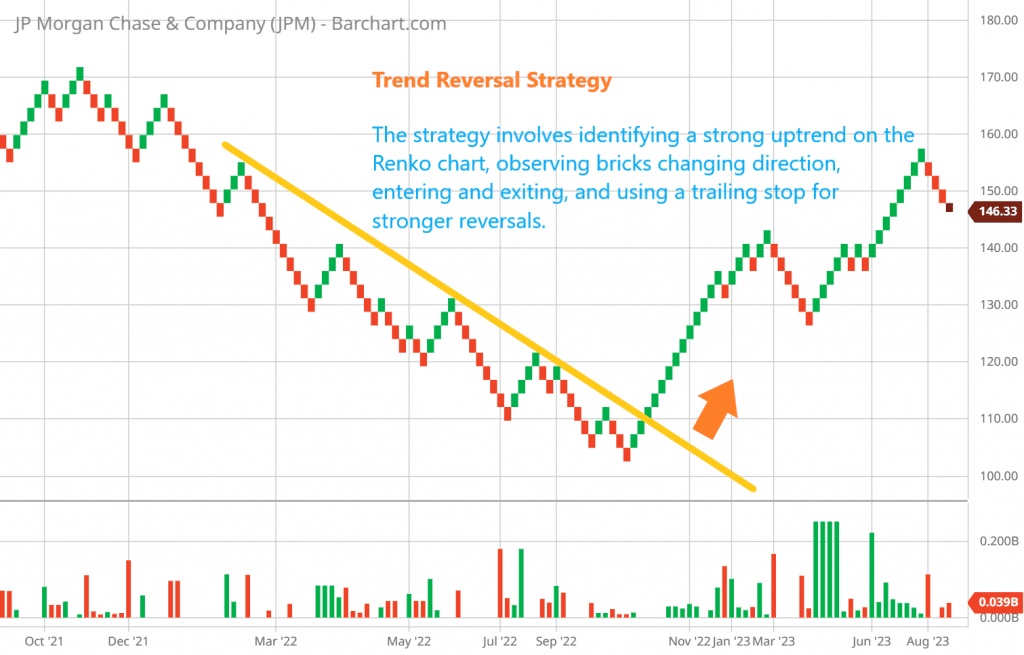
2. Breakout Strategy
- Setup: Identify a consolidation phase on the Renko chart where bricks form within a tight range.
- Entry: When a brick closes above or below the consolidation range, consider entering a trade in the breakout direction.
- Exit: Use the consolidation range’s height to set a target or employ a trailing stop to ride the trend.
Example: Imagine a stock that has been consolidating on the Renko chart. As bricks form within a narrow range, you wait for a breakout. Once a brick closes above the upper boundary of the consolidation range, you enter a long trade. To set your target, you calculate the height of the consolidation range and project it upwards. Alternatively, you can use a trailing stop to capture more gains as the trend develops.
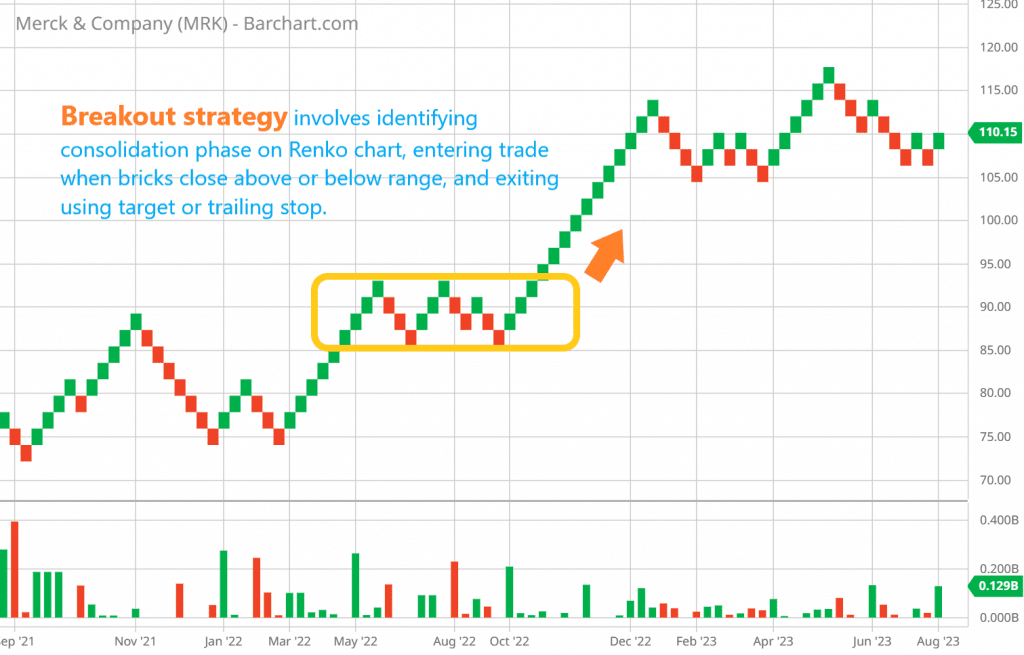
3. Moving Average Crossovers
- Setup: Combine Renko charts with two moving averages (e.g., 10-period and 20-period).
- Entry: Wait for a bullish Renko brick to close above the shorter moving average after a bullish crossover.
- Exit: Set a target based on price action or the longer moving average. Utilize a trailing stop to secure profits.
Example: Using a Renko chart alongside a 10-period and a 20-period moving average, you observe a bullish crossover. As a bullish Renko brick closes above the shorter moving average, you enter a long trade. For the exit, you set a target based on the recent swing high or the longer moving average. To protect gains, you also employ a trailing stop that adjusts as the trade progresses.
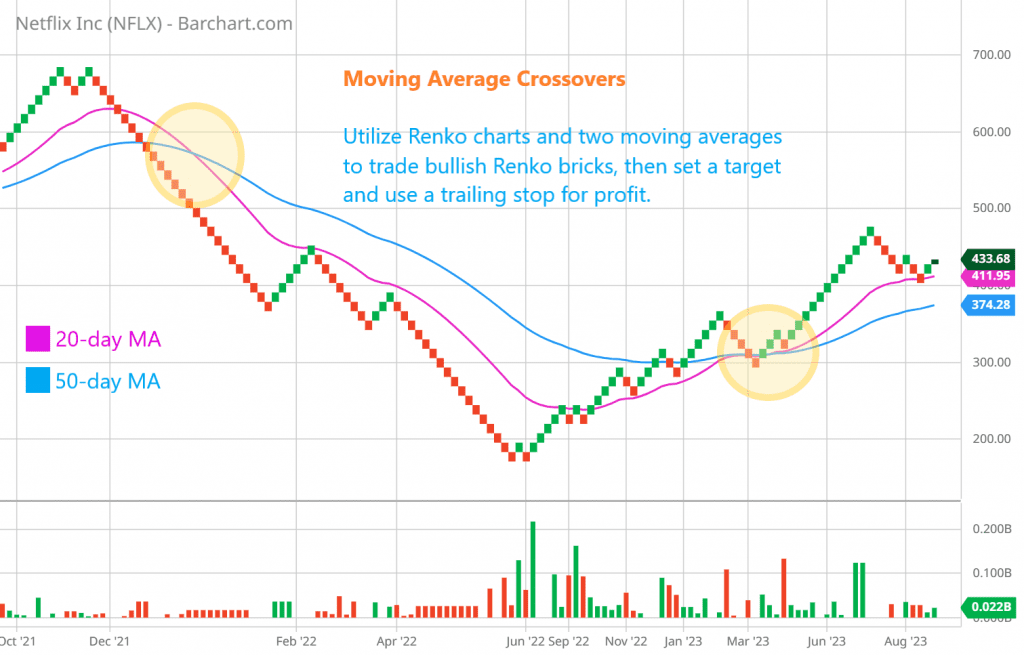
4. Fibonacci Retracement Strategy
- Setup: Identify a strong trend on the Renko chart and use Fibonacci retracement levels.
- Entry: Wait for a retracement to a key Fibonacci level and a bullish/bearish Renko pattern.
- Exit: Set a target near the recent swing high/low or a Fibonacci extension level. Employ a trailing stop for potential extended gains.
Example: While analyzing a Renko chart of a stock with a strong trend, you notice a retracement to a key Fibonacci level. Simultaneously, a bullish Renko pattern forms, indicating a potential reversal. This prompts you to enter a long trade. To determine your target, you consider the recent swing high and set a target just below it. For additional gains, you use a trailing stop, allowing you to capture profits if the trend extends further.
5. Dual Renko Strategy
- Setup: Use two Renko charts with different brick sizes (e.g., one with larger bricks and one with smaller bricks).
- Entry: Wait for signals to align on both Renko charts, indicating a high-probability trade.
- Exit: Utilize a combination of both Renko charts to set targets and manage stops.
Example: Employing dual Renko charts, one with larger bricks and the other with smaller bricks, you identify a trading opportunity. As a bullish Renko pattern forms on both charts, you see a strong alignment of signals. This high-probability setup prompts you to enter a long trade. To set your target, you consider both Renko charts and select a level that aligns with the larger timeframe chart. For managing the trade, you use the combination of both charts to adjust stops and protect profits.
Uncover 5 Powerful Renko Chart Patterns for Successful Trading
Mastering Renko Charts Technical Analysis: A Comprehensive Guide
Platforms for Swing Trading with Renko Charts
For those engaged in swing trading and keen on incorporating Renko charts, various trading platforms provide this capability. Here are some well-known choices, along with associated costs, advantages, and disadvantages:
TradingView
Cost: TradingView offers both free and premium subscription plans. The Pro plan, which includes advanced features, costs around $14.95 per month.
Pros:
- User-friendly interface with a wide range of technical analysis tools.
- Customizable Renko brick sizes and other chart settings.
- Social platform for sharing ideas and learning from other traders.
Cons:
- Some advanced features are only available in higher-tier subscription plans.
- Real-time data might require a separate subscription or integration.
MetaTrader 4 (MT4) and MetaTrader 5 (MT5)
Cost: MetaTrader platforms are free to use. Some brokers might charge for data feeds or offer premium services.
Pros:
- Widely used and trusted platforms in the trading community.
- Allows for algorithmic trading and custom indicator development.
- Access to a vast library of third-party indicators and tools.
Cons:
- Renko charts are not available by default; traders need to install custom indicators.
- Limited social interaction compared to platforms like TradingView.
NinjaTrader
Cost: NinjaTrader offers a free version with limited features. The full platform starts at $50 per month for a lease or $1,099 for a lifetime license.
Pros:
- Comprehensive trading platform with advanced charting capabilities.
- Customizable Renko charts and a wide range of technical indicators.
- Access to a marketplace for third-party indicators and strategies.
Cons:
- Higher cost compared to some other platforms.
- Learning curve for new users, especially those new to trading platforms.
FAQs (Frequently Asked Questions)
1. Can Renko charts be used for day trading or longer-term investing?
Renko charts are versatile and can be adapted to various trading styles. They are commonly used for day trading, swing trading, and longer-term investing strategies.
2. Do I need to pay for Renko charting services?
Some trading platforms offer Renko charting as part of their basic features, while others might require a subscription or an additional fee for advanced charting tools.
3. Can I use Renko charts alongside traditional charts?
Yes, many traders use Renko charts in conjunction with traditional candlestick or bar charts to get a more comprehensive view of the market.
4. How often should I adjust my Renko brick size?
The frequency of adjusting brick sizes depends on market conditions and the asset you’re trading. Generally, more volatile assets might require more frequent adjustments.
5. Are Renko charts foolproof for swing trading?
While Renko charts offer clarity, no trading strategy is foolproof. It’s important to combine Renko analysis with other indicators, perform thorough research, and practice effective risk management.
Conclusion
Renko charts offer a valuable perspective for swing traders aiming to capture trends while minimizing noise. By understanding their advantages, employing effective strategies, and using the right platforms, traders can harness the power of Renko charts to enhance their swing trading success. Remember that trading involves risks, and continuous learning and adaptation are key to achieving consistent results in the dynamic world of financial markets.



